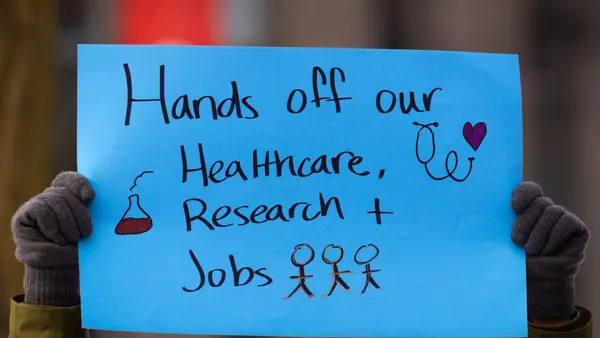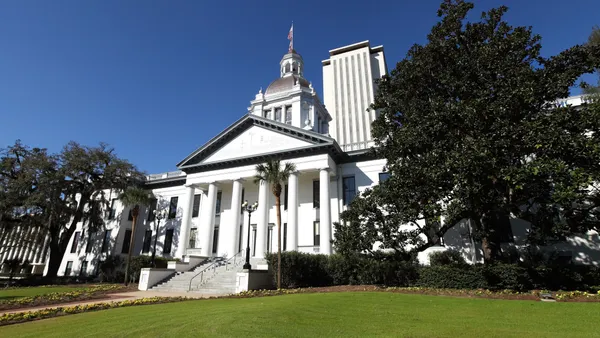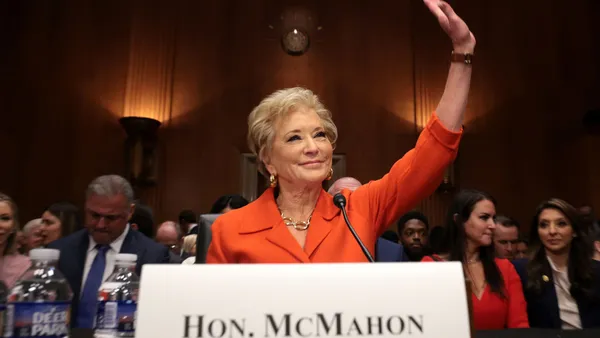Dive Brief:
- In the fiscal year 2017, 50 colleges received 30% of student veterans' Post-9/11 GI Bill benefits, about half of which went to for-profit colleges, according to a new report from the U.S. Government Accountability Office (GAO).
- That's compared to 25% of funds going to private nonprofit colleges and 22% to public colleges. Within the top 50 institutions, the share of students enrolled in each of the three college types mirrored the share of funds it received.
- The new data follows a spate of for-profit college closures this past winter and comes amid growing pressure to change key legislation governing how they calculate their revenue to include military benefits.
Dive Insight:
The abrupt shuttering of for-profit colleges run by Education Corporation of American (ECA), Vatterott Educational Centers and Dream Center Education Holdings (DCEH) from the end of 2018 to early 2019 left tens of thousands of students with an uncertain path forward.
It also drew renewed attention to the mix of faulty oversight mechanisms and heightened regulatory scrutiny that have contributed to the sudden closures of other major for-profit systems in recent years. More than 1,000 for-profit college campuses closed from 2014 to 2018 according to data reported by The Chronicle of Higher Education.
Sudden closures can leave students struggling to transfer credits and with little time to fully explore new options. The institutions also may have not established teach-out plans. Students at closed for-profits are particularly vulnerable, according to the GAO report. While students lost about 37% of credits when transferring between public institutions, those transferring from a for-profit to a public college lost nearly all (94%) prior credits.
The impact of school closures can be pronounced for student veterans, who are more likely to be attending a for-profit college and may also be "dealing with the effects of combat-related physical and psychological injuries," the report explains. The GAO report says "thousands" of student veterans were affected by the DCEH and ECA closures.
The expansion of the GI tuition benefit in 2008, along with a rule exempting those funds from counting toward for-profit colleges' maximum 90% revenue from federal aid, compounds the issue, Politico reported. For-profit colleges are known to focus heavily on recruiting veterans, looking to tap into their GI Bill, which doesn't count toward that 90%.
In 2016, an analysis found the number of colleges not compliant with federal funds reporting under the 90/10 rule would grow to almost 200 from 17 if Post-9/11 GI Bill benefits were considered.
Veterans advocates have been pushing Congress to amend the rule to include military education benefits in that 90% and to reduce the percentage. Proposed legislation in the House addresses those concerns, which go beyond the sheer impact of closures.
The GAO report notes student veterans at for-profit colleges were less likely to graduate in six years than those at public colleges and private nonprofits. The graduation rate for those at for-profits was also well below the national average. Full-time and part-time student retention rates were also lower at for-profits.
A separate audit last year from the Department of Veterans Affairs' (VA) internal watchdog group found GI benefits were going to programs that had issues with approvals, changes or reviews, or "potentially erroneous, deceptive, or misleading advertisements."
Not everyone is on board with changing the rule. In prepared remarks, the executive director of the education arm of the VA's Veterans Benefits Administration cited "significant concerns" over how the agency would implement proposed legislation to limit the share of revenue for-profits receive from federal sources.














